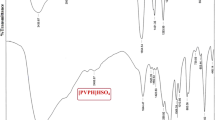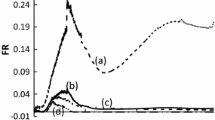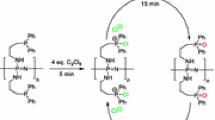Abstract
Different scavenging techniques using polymer-supported sequestration agents are described for the purification steps in the synthesis of N3-acylated dihydropyrimidines.For scavenging both excess anhydride and unwanted byproducts, polystyrene and silica supported diamines, aminomethyl-functionalized SynPhase Lanterns and diethylenetriamine StratoSpheres Plugs are used. In both synthesis and purification microwave flash heating was utilized, reducing reaction times from hours to minutes. These two steps coupled with an efficientsolid-phase extraction (SPE) workup allowed the generation of a 28-member library of N3-acylated dihydropyrimidines usinganhydrides. Using related protocols a 15-member library of N3-functionalized dihydropyrimidines utilizing acid chlorides as acylating reagents was also obtained.
Similar content being viewed by others
References
Ley, S.V., Baxendale, I.R., Bream, R.N., Jackson, P.S., Leach, A.G., Longbottom, D.A., Nesi, M., Scott, J.S., Storer, R.I. and Taylor, S.J., Multi-step organic synthesis using solidsupported reagents and scavengers: A new paradigm in chemical library generation, J. Chem. Soc., Perkin Trans. 1, (2000) 3815–4195.
Kirschning, A., Monenschein, H. and Wittenberg, R., Functionalized polymers-emerging versatile tools for solutionphase chemistry and automated parallel synthesis, Angew. Chem. Int. Ed., 40 (2001) 650–679.
Booth, R.J. and Hodges, J.C., Solid-supported reagent strategies for rapid purification of combinatorial synthesis products, Acc. Chem. Res., 32 (1999) 18–26.
Tzschucke, C.C., Markert, C., Bannwarth, W., Roller, S., Hebel, A. and Haag, R., Modern separation techniques for the efficient workup in organic synthesis, Angew. Chem. Int. Ed., 41 (2002) 3964–4000.
Eames, J. and Watkinson, M., Polymeric scavenger reagents in organic synthesis, Eur. J. Org. Chem., (2001) 1213–1224.
For a preliminary report on this subject, see: Dallinger, D., Gorobets, N. Yu. and Kappe, C.O., High-troughput synthesis of N3-acylated dihydropyrimidines combining microwaveassisted synthesis and scavenging techniques, Org. Lett., 5 (2003) 1205–1208.
For a recent review, see: Kappe, C.O., Recent advances in the Biginelli dihydropyrimidine synthesis. New tricks from an old dog, Acc. Chem. Res., 33 (2000) 879–888.
For a review, see: Kappe, C.O., Biologically active dihydropyrimidones of the Biginelli-type – A literature survey, Eur. J. Med. Chem., 35 (2000) 1043–1052.
Stadler, A. and Kappe, C.O., Automated library generation using sequential microwave-assisted chemistry. Application toward the Biginelli multicomponent condensation, J. Comb. Chem., 3 (2001) 624–630.
Dallinger, D. and Kappe, C.O., Selective N1-alkylation of 3,4-dihydropyrimidin-2(1H)-ones using Mitsunobu-type conditions, Synlett, 11 (2002) 1901–1903.
Kappe, C.O., 100 years of the Biginelli dihydropyrimidine synthesis, Tetrahedron, 49 (1993) 6937–6963.
Kappe, C.O. and Roschger, P., Synthesis and reactions of ‘Biginelli-compounds’, J. Heterocyclic Chem., 26 (1989) 55–64.
Folkers, K. and Johnson, T.B., Researches on pyrimidines. The acetylation of 2-keto-tetra-and hexahydropyrimidines, J.Am. Chem. Soc., 56 (1934) 1374–1377.
Palmacci, E.R.; Hewitt, M.C. and Seeberger, P.H., ‘Captag’ – Novel methods for the rapid purification of oligosaccharides prepared by automated solid-phase synthesis, Angew. Chem. Int. Ed., 40 (2001) 4433–4436.
McComas, W., Chen, L. and Kim, K., Convenient synthesis of 2,9-disubstituted guanines mediated by solid-supported reagents, Tetrahedron Lett., 41 (2000) 3573–3576.
Thompson, L.A., Combs, A.P., Trainor, G.L., Wang, Q., Langlois, T.J. and Kirkland, J.J., Functionalized porous silica microspheres as scavengers in parallel synthesis, Comb. Chem. High Throughput Screen., 3 (2000) 107–115.
Atrash, B., Bradley, M., Kobylecki, R., Cowell, D. and Reader, J., Revolutionizing resin handling for combinatorial synthesis, Angew. Chem., 113 (2001) 964–967.
Feliu, L., Subra, G., Martinez, J. and Amblard, M., Spiroimidazolidinone library derivatives on SynPhase Lanterns, J. Comb. Chem., 5 (2003) 356–361.
Wu, Z., Ede, N.J. and Mathieu, M.N., Solid-phase synthesis of benzimidazole N-oxides on SynPhase Lanterns, Tetrahedron Lett. 44 (2003), 2293–2296.
Author information
Authors and Affiliations
Corresponding author
Rights and permissions
About this article
Cite this article
Dallinger, D., Gorobets, N.Y. & Kappe, C.O. Microwave-assisted scavenging of electrophiles utilizing polymer-supported sequestration reagents. Application to the synthesis of N3-acylated dihydropyrimidine libraries. Mol Divers 7, 229–245 (2003). https://doi.org/10.1023/B:MODI.0000006865.59065.bf
Issue Date:
DOI: https://doi.org/10.1023/B:MODI.0000006865.59065.bf




